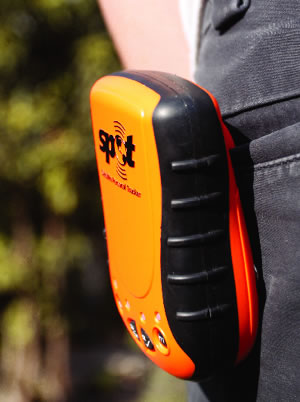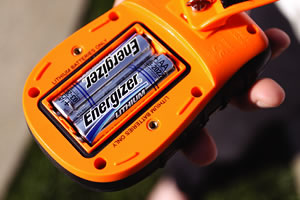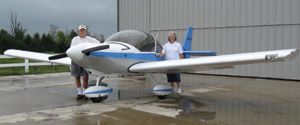Editors Note: After we ran a short review of the SPOT Personal Tracker (KITPLANES February 2009) we received notice through a reader about the following study, conducted by navigation expert Langley R. Muir and provided to CASARA, the Canadian Air Search and Rescue Association. It is reprinted here with our thanks to the author.
It seems like such a good idea: A small device that will let people communicate with home or emergency services where cell phone coverage doesn’t work. Its significantly cheaper than satellite telephones but more flexible than personal locator beacons. The SPOT satellite personal tracker is a great product that should have a huge market amongst a wide variety of outdoor people. The company is aggressively marketing it as a safety device for anyone who goes away from home, and it is available at most outdoor stores and even through London Drug Stores.

The LEDs indicate whether the unit is on, which mode its in, and the battery charge. The four buttons allow the user to send different kinds of messages including a 911 alert or a simple status update.
I have recently had the opportunity to do extensive testing on the device under a variety of circumstances. My tests show that though SPOT does work as advertised, it does not work as well in practice as an unwary user might expect and could, in some cases, actually be worse than having nothing at all. If, however, you realize and can accept its limitations, it can be quite useful. Other independent tests of SPOT-including ones published on the Cnet.com and USA
Today.com web sites-tend to substantiate my findings. My test applications are in small aircraft, automobiles and hiking, skiing and canoeing in Ontario, Quebec, Alberta and British Columbia.
If SPOT worked perfectly and were reliable, the market among aviators, boaters, automobile travelers and all sorts of outdoors people would be huge. The problem is the reliability of the device. If you are in trouble and you need to rely on it to alert the emergency services, it had better work. If it doesn’t, but you think it did, you may well be waiting around to get rescued when you should be working as hard as possible to rescue yourself. With experience, you can get a good idea of whether someone might be receiving the messages you are sending, but you could also get misled, and there is nothing to confirm that any message was ever received by anyone. In addition, if your track messages suddenly stop because of transmission problems while you are still out there, those who are following you could initiate an entirely unwarranted search and rescue effort.

Wearing SPOT on the belt clip orients it vertically, but it should be oriented horizontally, logo up, for best results.
How Does It Work?
SPOT is a small, bright orange device with a GPS receiver, a low-powered L-band radio transmitter, four buttons and four LEDs, which operates for a long time on two lithium AA batteries.
Once you register it, pay the subscription fee and turn it on, you have the option of sending an OK message, a pre-programmed message (usually some sort of non-urgent Help) or a 911 message, or you can track your location with a message sent approximately every 10 minutes. The OK or Help messages can go up to five different e-mail addresses; the track message is saved for 30 days in an Internet accessible and downloadable file. The 911 message is not only sent to the e-mail addresses, but the SPOT people will actually alert the appropriate search-and-rescue centers and get SAR teams on the way. All of the messages are tagged with the time and GPS position, and they come with a hyperlink to show the position on Google Maps. The system is extremely robust, floats, and would survive a large fall. Current U.S. price for the unit is $169.99, with a years service an additional $99.00; tracking is another $49.99 a year. For $7.95 a year, up to $100,000 of rescue insurance is also available.
The first thing it does, when on, is lock onto the normal GPS satellite system and get the time and your location. Although the manual says that the blinking On/Off light indicates that it is locked onto the GPS system, in fact the light merely shows that SPOT is attempting to lock on. When I turned it on inside a metal-lined room, where there are no electromagnetic signals getting in at all, the light still flashes. According to the Canadian representative, it actually only acquires a GPS signal when it is about to send a message, which helps to conserve battery power. There is no indication of the signal strength, the satellites being received or your actual position, and you have no idea whether it has a GPS signal. In the event of you sending an emergency message without a GPS signal, the device will still send a message-but without the location.
The second thing that SPOT does is send the appropriate signal to the Globalstar satellite system, which in turn sends it to a Globalstar ground station where the message is processed and forwarded via the public telephone system and the Internet.
Users of handheld ground-based GPS units or radios will be aware that there are problems with receiving or transmitting a signal when you do not have a line of sight between transmitter and receiver. Dense bush, or being at the bottom of valleys, underground, in buildings or vehicles can easily degrade the signal, as can being in a thunderstorm. There have been many improvements in antenna design and signal processors lately, but just turning the SPOT on is no indication that it is actually processing a signal. And, for that matter, just because the signal is sent, there is no assurance that it was received at the ground station.
The Satellite System
In 1992, Globalstar started to launch satellites and, after many trials and tribulations, began commercial operation in February 2000 with 48 operational satellites along with four spares. Initial tests showed excellent service on the telephone system, but the S-band duplex amplifiers started to degrade seriously in 2005.
In 2006, Globalstar announced a second generation of satellites that should remain operational until 2025 and which would take care of problems with the duplex telephone system. The company, in its 2007 SEC submission, anticipated almost complete loss of voice service sometime in 2008, though a number of technical solutions in the works would restore it by 2009. However, SPOT relies entirely on the L-band simplex system, and there are no problems there.
The L-band system is commonly used in all sorts of asset tracking devices and in the transportation industry where there is generally no problem with good sky views. It is a simplex system, however, and signals pass only one way; it would be impossible for SPOT to be inexpensively reworked so that you could get confirmation that your signals have not only been sent, but also received at the other end.
Unlike the Iridium phone system, which will pass a signal from satellite to satellite until it can send the signal to a ground station, Globalstar uses a bent-pipe technology, meaning that the sender, a single satellite and a ground station must all be in line of sight before any signal can be passed. The Globalstar satellite cluster operates only up to about 68 N, so there is not, nor will there be, coverage in the Arctic (or in Africa or at sea due to the lack of ground stations). If you know your approximate position, you can go to the Globalstar web site and download the optimum times for transmission, which will help with the telephone system but should not be necessary for SPOT. A map of current coverage with ground station locations is also available on the Globalstar web site.
Summary Data Table | Number of Trials | Total Number of Data Points | Percent Data Return | ||
|---|---|---|---|---|---|
Usage Mode | Received | Expected | Average | Minimum | |
Stationary | 3 | 80 | 117 | 68 | 50 |
Aircraft, high wing | 15 | 333 | 420 | 79 | 40 |
Vehicle | 16 | 274 | 333 | 82 | 40 |
Hiking, summer | 5 | 21 | 70 | 30 | 19 |
Skiing, winter | 13 | 205 | 438 | 47 | 18 |
Canoeing | 5 | 21 | 71 | 30 | 0 |
Design Factors
Usability of the SPOT device itself is a bit of a mixed bag. It is extremely robust, built to military specifications, floats, and can survive a large fall. The antenna is under the logo, and it is important to hold the device horizontally with the logo up to ensure the best possible transmission. If it is in a pack or inside a sweaty shirt pocket, signals may not get out to the satellite.
The belt-clip virtually ensures that many people will carry it on their belts, oriented vertically, when it should be horizontal as it would normally be if placed on an automobile or aircraft dashboard. In any case, the belt clip is not secure. Because there is no positive locking device, it can easily be detached from a belt or a pack by a passing branch or awkward movement. There is a tiny hole through which you could put a lanyard to attach the device to yourself, but it should be much bigger and easier to use.

The SPOT unit runs on two AA lithium batteries. Alkaline batteries will also do in a pinch, but will degrade performance.
The device requires lithium-ion AA batteries to ensure design performance over a long period of time and in cold weather. In emergencies, alkaline batteries could be used, albeit with seriously degraded endurance. The buttons used to activate the functions are quite small and need to be held down for at least 2 seconds to protect from inadvertent operation. They are difficult to use with gloves and impossible with mitts.
The flashing lights can be ambiguous. Pushing the On/Off button for more than 2 seconds results in a flashing green light every 3 seconds and simply turns the device on. Pushing the OK button for 2 seconds results in both lights flashing every 3 seconds and sending an OK message. It can, however, take up to 10 minutes (according to the manual and up to 20 minutes by test) for the message to actually get sent. Pressing the OK button for more than 5 seconds puts the device into tracking mode and, again, both lights flash every 3 seconds. There is no indication which of the two possible modes the device is in, and you cannot be in two modes at once; so you cannot send an OK message while the device is tracking, and you cannot start tracking while it is waiting to send its OK message.
When the device sends a signal, the green lights turn solid for 5 seconds, but this is easy to miss and there is, effectively, no way of knowing whether a signal has been sent and, as mentioned before, received at the ground station. There are separate buttons for the HELP and 911 messages, and sending these overrides any other messages. A flashing red light starts when the lithium batteries are below 30% charge so that you should have lots of time to change the batteries. According to the Canadian representative for SPOT, some of these limitations are being addressed in the next iteration.
SPOT, Tested
How well does the device operate in practice? If you maintain a clear view of the sky-the manual says you need 80%-then all seems to go well. However, there is seldom a case where you have this much visibility unless you are in the middle of a large flat spot such as a lake, desert or airport, or on top of a treeless mountain. Real-world practice is what actually counts, and it is here that SPOTs limitations show up. In fact, you don’t need much view of the sky; all you really need is a clear view of a satellite while it has a clear view of a ground station. On the other hand, the critical portion of the open sky view can easily be blocked by buildings, hills and, most importantly, trees, which are not mentioned in the manual. There are a lot of trees in Canada. In order to get an 80% unimpeded view of the sky, you can have nothing above an elevation of 18 from the horizon. A 33-foot-high obstruction anywhere within 100 feet could be problematic. The tests also show that cloud cover can degrade the reception significantly.
Complete data from all of the tests is available from the author. However, the Summary Data Table gives an idea of what can be expected. In an aircraft windscreen, where there is a good view of the complete sky, data returns over 95% can be expected. In an automobile windscreen or motorbike on a wide, divided highway, or in a canoe in the middle of a lake, or even in a carefully selected open area, returns of over 90% are common.
Its not always easy to determine if a signal can get through. In the case of the Stationary 1 test, the device was placed on a table outside with a single layer of tree cover to the south, and the data return was 54%. The Stationary 2 test was done with the device indoors on the south side of the house approximately 5 meters north of the first location and approximately 1.5 meters inside a second floor window covered with a metal blind to within 10 centimeters of the sill and the same tree cover to the south. Even here, with a limited view of the southern sky, we still got about a 54% data return.
Generally, the percent returns drop off quickly as the view of the sky is degraded. If the device is in the pocket of a damp shirt or buried in a pack, few data returns were received. In the bush, with trees and hills about, no data got through. It is generally possible, however, by choosing an open spot with a good view to the south and low obstructions on the horizon, to ensure the message gets through. However, one must be careful of the location. Although almost all of the messages were received by e-mail within a minute or two of sending them, there were a couple of cases where the delay was up to 45 minutes.
Depending on what you are trying to do, SPOT can be very useful. If you simply want to track aircraft in flight or vehicles in transit on good, wide roads, then you are probably in pretty good shape. In these cases, the data returns are on the order of 95%, and it doesn’t really matter much if one or two data tracking points are missing. If you travel in mountainous terrain or on narrow roads, and the clear view of the sky can be compromised, then you will have to accept a lesser data return. If you want to send other sorts of messages, then it depends a bit on how flexible you are in choosing when and where you can send the messages and how important it is to know whether the message got through. It is also important to warn people who are using SPOT to follow you that you might well have periods of no data return due to transmission difficulties. You would not want them to start an unwarranted search effort simply because SPOT slipped in your pack or you are under a tree.
Your Options
In light of all this, what are the options? A 406 MHz PLB, EPIRB or ELT radiates 5 watts of power that is satellite tracked, with a low-power 121.5 MHz signal for homing. The 5-watt signal ensures that messages will get out unless you are in an extremely bad position. If you push the button, a full SAR effort begins; otherwise, it sits storing batteries. The high power, lower frequency and multiple, moving satellites all help to ensure a signal will be picked up.
A satellite phone is expensive and has about 500 to 800 milliwatts output, which is generally adequate if you have a reasonably clear view of the sky. You can talk to anyone and your messages can be as precise as you wish. If the message cannot get out, you’ll know it.
The SPOT device radiates at only 83 milliwatts, is inexpensive and allows you to send up to four types of message. As stated before, you cant be sure the messages have gotten through, but with a bit of care you can improve your chances significantly. If you are on the ground and travel with a group, and wish to remain in some contact with the outside world and can ensure proper positioning, SPOT will convey one of four possible messages-including an urgent call for help. If you travel on your own and want to be fairly sure that you can summon help when you get in trouble, then you need to have either a PLB/EPIRB/ELT or a satellite phone. If you are alone at the bottom of a cliff or in dense bush, and you’re immobile or unconscious, then nothing will work for you.
Summary
Generally, the SPOT has many uses and outperforms the limitations suggested in the user guide. If you travel in aircraft or in vehicles on broad, open highways, then SPOT should give you excellent performance. If you want to be able to send a message while in the bush or the mountains and can afford to wait until you or your companions can get to a clear, unimpeded view of the sky, then SPOT looks like it will give you excellent performance.
If you wish to be able to call 911 when you have crashed your airplane or your car is in among the trees, or you are injured while in the woods, the mountains, or the canyons, then you may well be out of luck. The other options will probably give you a better chance of being helped, but not necessarily. That is what risk management is all about-deciding what trade-offs and limitations you are willing to accept based upon the likelihood of an incident and the probable consequences.




